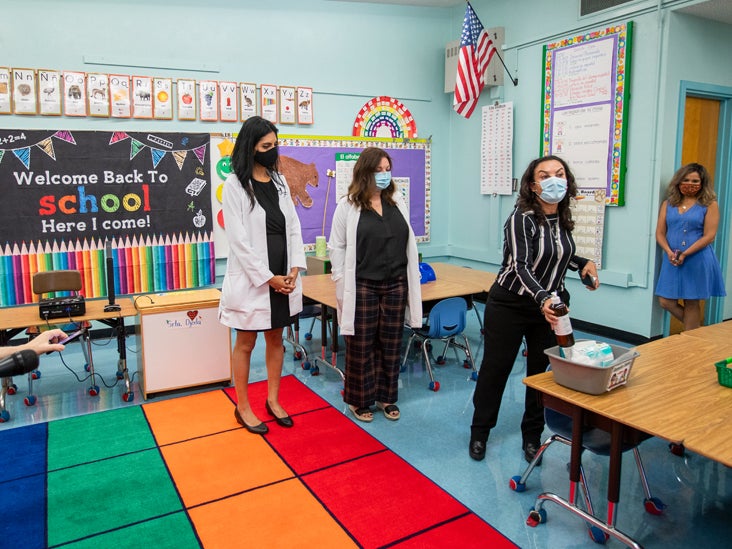The New U.S. School Year
12 min read

- Experts have previously estimated that the United States needs a vaccination rate of at least 75 percent to reach “herd immunity” level.
- Now with the more infectious Delta variant, a higher ratio may be needed as more “breakthrough” cases are reported.
- But with more than 22 percent of the population under age 18, it’s crucial that kids get vaccinated to reach those numbers, because not all adults want to or can get vaccinated.
- For individual health, public safety, and continuity of education, vaccinations must remain top priority before schools start, say experts.
If schools return to in-person education as planned this fall, how likely are we to see COVID-19 outbreaks or school closures?
For educators, closures are not an option. They are adamant that kids do not lose a third year of school to the pandemic and get the social stimulation they need.
An analysis by McKinsey, a management consulting firm, estimated that the pandemic left students about 5 months behind in mathematics and 4 months behind in reading.
As of August, just more than 29 percent of kids ages 12 to 15 have been fully vaccinated.
That relatively low figure puts that age group at the bottom of the list of progress with the lowest number of vaccinated members.
With schools slowly starting to open in the United States, that vaccination rate carries great significance for the new school year.
Outbreaks have already started to happen. Since the end of July, at least nine schools across North Carolina have reported clusters of infections and more than 93 active cases.
The American Academy of Pediatrics (AAP) found that more than 94,000 cases of pediatric COVID-19 were documented in a single week.
But international studies have also shown that schools have reopened safely as long as community transmission is low.
In Italy, a cohort study found that reopening schools did not contribute to the second wave of the pandemic if prevention strategies were in place. Among such measures were face masks, physical distancing, and screening testing. However, this study occurred before the Delta variant was widespread.
In the United States, experts point out that as long as the majority of eligible people are vaccinated and schools can take swift action to contain such clusters, the risk of a full-fledged outbreak can be reduced, experts say.
But with so few eligible children vaccinated against the disease, we talked with pediatricians about what we can expect this school year.
Herd immunity stands as an important element in the national and global fight against COVID-19. It refers to enough people developing natural immunity (via infection) or acquired immunity (via vaccination) to a pathogen, and the pathogen losing its ability to spread within a community.
In the early days of the pandemic, epidemiologists had estimated a herd immunity level of 65 to 70 percent was needed for herd immunity. But with the rise in Delta variant cases, more experts have edged the minimum limit higher and higher.
As far back as December 2020, Dr. Anthony Fauci, director of the National Institute of Allergy and Infectious Diseases, said a herd immunity level of at least 75 percent to over 80 percent was more likely to make a return to normal possible.
But to reach that level, a significant number of children and teens will need to get vaccinated. In the United States, people under age 18 make up more than 22 percent of the total population.
Dr. Alok Patel, a pediatrician at Stanford Children’s Health, broke down what a low level of vaccination in youth would mean for the wider population for Healthline.
More vulnerable children are more likely to contract and transmit the coronavirus. Additionally, this allows the virus more time to replicate and potentially mutate into a virulent and/or transmissible variant.
Patel said it’s paramount for anyone above the age of 12 to get vaccinated as soon as possible.
“The Delta variant is acting like a homing missile targeting the unvaccinated, with cases rising all over the country. Children are less likely to be hospitalized, but they can pass on the virus to others, including those who are at higher risk, such as grandparents or anyone with an underlying medical condition,” he said.
Dr. Deborah Greenhouse, a pediatrician in Columbia, South Carolina, underscored that vaccination was absolutely crucial to record progress in the pandemic.
“We cannot get past this without very high immunization rates. We have never been able to eradicate a virus or get out of a pandemic without a vaccine before, and there is no reason to think that we would this time,” she told Healthline.
Echoing Patel’s comments, Greenhouse said subpar levels of vaccination will inevitably lead to more virus variants emerging.
“As these variant strains emerge, they are more contagious and can cause more severe disease sometimes, just like what we are seeing with the Delta variant now. And the only way we can prevent these variant strains from emerging is to have a high enough vaccine rate so that these variants have nowhere to go, so they don’t have a host,” Greenhouse said.
With COVID-19, there’s another dimension to think about: persistent, long-term symptoms, or “long-haul COVID-19,” as it has come to be known.
Besides hospitalization and deaths, these long-term complications are very real problems, said Dr. Annabelle de St. Maurice, assistant professor of pediatrics in the division of infectious diseases at UCLA Health.
“This can really impact a child’s mental and physical health, and we do not know for how long and we do not have great treatment strategies for long-term treatments,” she told Healthline.
Patel said the full scope of long-haul COVID-19 is still unknown, but “plenty of children and teens have presented with symptoms lasting weeks, if not months, after an initial positive SARS-CoV-2 test.”
However, de St. Maurice pointed out that not everyone who has COVID-19 has these long-term symptoms.
“[What makes it more challenging is that] we still do not understand the prevalence of long-term symptoms in children, and we certainly wouldn’t want to put our children at risk,” she said.
Greenhouse said she’s already seeing cases of long-haul COVID-19 in kids and adolescents. The added challenge with younger children is to get them to describe it to you.
She said severe acute illness, nevertheless, remains a big concern.
“Look at our children’s hospitals now. The rates keep going up. One that keeps being politicized is Arkansas’ children’s hospital. It has more kids hospitalized than they had at any point in the pandemic. They have lots of kids in ICUs, and they have several kids on ventilators right now.”
— Dr. Deborah Greenhouse
Greenhouse stressed that the whole narrative that COVID-19 is a mild disease for children is simply not true.
“Most children do very well with it, but some don’t. And we can’t necessarily predict who those kids are going to be,” she said.
Patel drew attention to the lack of studies investigating the true likelihood of long-haul COVID-19 in children, but that it’s a phenomenon happening worldwide.
“Children are presenting with headaches, fatigue, chest pain, difficulty breathing, mental illness, and other symptoms. Awareness regarding the interdisciplinary care needed for long-COVID haulers is increasing, and so is the outright urgency to prevent it, which is via vaccines,” he said.
The phrase “pandemic of the unvaccinated” is another newly coined phrase that has dominated discussions about COVID-19.
Greenhouse said that right now with the major surge in COVID-19, the outbreak isn’t just confined to unvaccinated people.
“Do I think it is just the pandemic of the unvaccinated? No. But do I think this is fueled by the unvaccinated and far more severe in the unvaccinated? Absolutely,” Greenhouse said.
She explained the most severe cases are still being seen in unvaccinated people. Most new hospitalizations and deaths are largely among unvaccinated people, although there have been cases where vaccinated people have also gotten sick.
“I think that what we are seeing now is that the most severe effect is on the unvaccinated, both those who have refused and those who cannot be vaccinated, such as those under age 12. [A]t the same time, we are seeing cases in fully vaccinated adults, even though they tend to be not as severe. But we are seeing far more of them, and that is really concerning,” Greenhouse said.
Patel said the numbers speak for themselves.
“We see the headline ‘breakthrough infection’ but really, that’s only referring to those who are vaccinated and testing positive. That is not referring to vaccinated individuals being hospitalized,” he said.
“Those who are hospitalized by COVID-19 are, by and large, unvaccinated. The unvaccinated individuals in this country represent more than 99 percent of all serious cases of COVID-19,” Patel said.
An Associated Press analysis of government data found that 0.8 percent of COVID-19 deaths in May were in fully vaccinated people. That means more than 99 percent of deaths were in unvaccinated people.
The burden of COVID-19 on the healthcare system is also one that cannot be overlooked.
“Our hospital back in December and January was full of patients with COVID-19, and it made it difficult taking care of patients with and without COVID-19,” de St. Maurice said. “Taking care of a COVID-19 patient is really time intensive: putting on and taking off PPE [personal protective equipment], doing all the infection control practices… it takes a lot of time.”
In the meantime, Greenhouse expects a rise in vaccination rates as disease rates continue to climb.
“What I’m seeing in my practice and what I am hearing from my colleagues throughout the country and through the AAP is that parents are starting to take notice,” she said.
Greenhouse said the vaccines’ safety and efficacy data was really good, and this will likely contribute to an increase in vaccine uptake.
“But is that going to be enough to prevent outbreaks once schools start, which in a lot of places will be in a couple of weeks? Probably not,” she added.
De St. Maurice said there’s certainly a component of hesitancy in parents with regard to the COVID-19 vaccine in kids ages 12 and up.
Patel has found it’s a combination of hesitancy and a lack of urgency.
“Earlier in the summer, as polls suggested, parents often said they wanted to ‘watch and wait’ before getting their teens the shot. Additionally, I heard from teens who were apathetic about getting the shot saying they felt they were low risk, protected, or that the pandemic was ‘blown out of proportion,’” he said.
But that narrative has started to shift with a rise in pediatric and adult hospitalizations.
“Recently, I’ve seen more teens coming out in favor of the vaccine, likely related to surges of the Delta variant. Just last week, in the hospital, I spoke to a teenager and her parent who both decided to now get the vaccine, because several family friends, including children, tested positive for COVID-19.”
— Dr. Alok Patel
Greenhouse said the hesitancy often comes from “a position of love and protection.”
“I understand where their hesitation is coming from. They are more willing to take risks for themselves than to take risks for their children. I understand that,” she said.
“At the same time, I try to spin that concern into a ‘Hey, let’s look at the risk of the disease for your child as compared to the risk of the vaccine for your child.’ I think that is where the conversation needs to go,” Greenhouse said.
She expressed hope that the vaccines for kids won’t be as politicized as they have been for adults in the United States.
The biggest challenge, according to de St. Maurice, will be communication going forward.
In particular, it will be dealing with the different guidance offered by different entities and trying to instill a sense of trust in parents and students.
The messaging from public health authorities so far has not been consistent. Guidance has often changed. In light of the latest data, however, authorities are converging on the need to wear a mask.
The Centers for Disease Control and Prevention (CDC) and the AAP currently recommend all children wear a mask, regardless of vaccination status.
A lot of pediatricians, like de St. Maurice, are in favor of universal mask wearing in schools.
Another challenge will be dealing with mixed classrooms, i.e., vaccinated and unvaccinated kids.
In Los Angeles County, de St. Maurice said around 45 percent of children are vaccinated, so more than 1 in 2 children will be unvaccinated.
“Dealing with some of the stressors of having to manage this mixed classroom will be difficult too,” she said.
All three doctors Healthline spoke with agree that the most important thing schools can do right now is to encourage students who are eligible to get vaccinated.
“I think the additional measures are also important. You do need to make sure children are wearing masks, that your ventilation standards are up to date, that you have the ability to do physical distancing, and you also screen children coming into school who are sick for symptoms and make sure they stay home,” added de St. Maurice.
Greenhouse said that another challenge will be dealing with different vaccination rates and policies across the country.
Schools across the United States start at varying times. In the South, the school year starts earlier, in August. Some Northern states do not start until after Labor Day in September.
Northern states will have the ability to see what happens in places that start a few weeks early. They’ll have a couple weeks to see whether Southern states’ tactics are working, or if they need a drastic change in policies to stop transmission.
In a sense, schools that start later will be able to learn from others’ mistakes.
Calling state-wide decisions “a very interesting dynamic,” Greenhouse said such discrepancies were largely because things tend to be politicized.
There are considerable differences, especially when it comes to vaccine statistics, in so-called red and blue states. Red states such as Florida and Arkansas have some of the lowest vaccination rates in the country.
For example, in South Carolina, where Greenhouse is based, COVID-19 vaccination rates are very low, with 41 percent fully vaccinated. Meanwhile, Vermont has the highest full vaccination rate in the country at 68 percent.
Where you live will also determine what measures you will need to follow at school, she said.
“In areas where they are following guidance from the CDC and public health experts, the children will be wearing masks in school, they will be using the precautions they can use, and encouraging vaccines. I would expect those schools to do quite well,” Greenhouse added.
Nine states, including California, Connecticut, Hawaii, New York, and Washington, have indoor mask mandates.
In states such as South Carolina, Arkansas, Florida, Iowa, Montana, Tennessee, and Texas, where officials have forbidden local officials and schools from enforcing mask mandates, such measures will be scarce.
Schools in South Carolina could face the risk of losing state funding if they implement a mask mandate.
“Unfortunately, unless something changes and our vaccine rates [remain] low, I would expect we will not do well,” Greenhouse said. “[T]here are lots of people, like myself, who are trying to change the trajectory by trying to educate parents and the school districts.”
Although by law mask wearing cannot be enforced, a strong recommendation could get more parents and kids to wear one, she said.
“Quite frankly, I see that as our only hope,” Greenhouse said.
As a parent, you have many choices when it comes to schooling and vaccinating your kids against COVID-19.
Very select schools will offer hybrid education this year. Most will return to in-person teaching. Homeschooling remains an option for parents with concerns of this shift.
If your child is too young to get the vaccine or not yet eligible, doctors say the best thing you can do is to get yourself and other members of the household vaccinated.
If your kid is old enough, it’s up to you to weigh the risks of vaccination and your child possibly getting COVID-19 and having complications.
Medical experts agree that vaccination is the way to go.
“What I have been telling [parents] is that there is good research going on, and people are monitoring this all the time. Thus far, these vaccines seem very safe and very effective with few side effects, and those are typically brief and self-limited,” Greenhouse said.
One way to put things into perspective: “There are at least as many unknowns about the disease as there are about the vaccine at this point,” she said.
Once schools open, if your child has any symptoms such as a sore throat, runny nose, or cough, keep them at home and let them rest.
Most importantly, schools and parents will need to be flexible this school year.
There may be developments that change the course of the pandemic, and authorities may implement new measures accordingly to prevent further transmission.
North Carolina, for instance, has introduced a mask mandate after several outbreaks at charter schools.
Until then, the CDC, AAP, and many healthcare professionals are encouraging teens and kids to get vaccinated and mask up.
The most effective strategy remains mass vaccination and multilayered protection with masks, physical distancing, and adequate ventilation.


